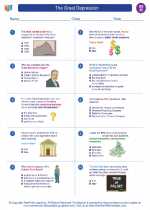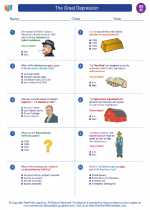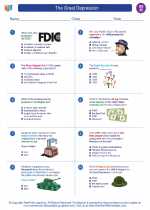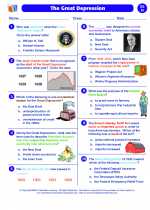The Great Depression
In the last years of the decade commonly referred to as the Roaring Twenties, the United States saw a great gap between the rich and the poor citizens. Businesses and corporations were booming and productivity rose. However, increased production and decreased consumption took its toll and eventually the American people saw a drastic fall in the stock market. The stock market crash virtually ruined the American economy of the time and the greater part of the next decade was spent trying to reverse the damage. Read More...
◂Social Studies Worksheets and Study Guides Eighth Grade. The Great Depression
Study Guide The Great Depression
The Great Depression  Worksheet/Answer key
Worksheet/Answer key The Great Depression
The Great Depression  Worksheet/Answer key
Worksheet/Answer key The Great Depression
The Great Depression  Worksheet/Answer key
Worksheet/Answer key The Great Depression
The Great Depression  Worksheet/Answer key
Worksheet/Answer key The Great Depression
The Great Depression 

 Worksheet/Answer key
Worksheet/Answer key
 Worksheet/Answer key
Worksheet/Answer key
 Worksheet/Answer key
Worksheet/Answer key
 Worksheet/Answer key
Worksheet/Answer key

The resources above cover the following skills:
National Curriculum Standards for Social Studies (NCSS)
TIME, CONTINUITY, AND CHANGE
SOCIAL STUDIES PROGRAMS SHOULD INCLUDE EXPERIENCES THAT PROVIDE FOR THE STUDY OF THE PAST AND ITS LEGACY.
KNOWLEDGE - Learners will understand:
Concepts such as: chronology, causality, change, conflict, complexity, multiple perspectives, primary and secondary sources, and cause and effect.
National Center for History in Schools (NCHS)
Historical Thinking Standards
Historical Comprehension
Reconstruct the literal meaning of a historical passage.
Historical Analysis and Interpretation
Analyze cause-and-effect relationships and multiple causation, including the importance of the individual, the influence of ideas.
United States History Content Standards
Era 8: The Great Depression and World War II (1929-1945)
The causes of the Great Depression and how it affected American society.
The student understands the causes of the crash of 1929 and the Great Depression.
The student understands how American life changed during the 1930s.
How the New Deal addressed the Great Depression, transformed American federalism, and initiated the welfare state.
The student understands the New Deal and the presidency of Franklin D. Roosevelt.
The student understands the impact of the New Deal on workers and the labor movement.
The student understands opposition to the New Deal, the alternative programs of its detractors, and the legacy of the New Deal.
Era 10: Contemporary United States (1968 to the present)
Recent developments in foreign and domestic politics.
The student understands domestic politics in contemporary society.